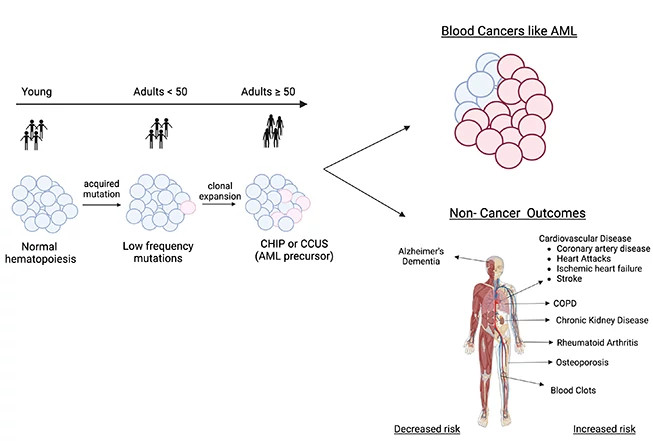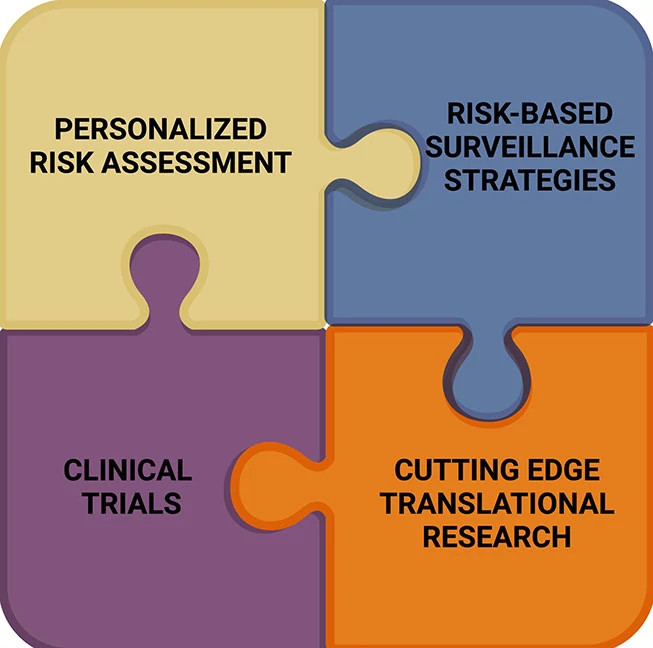Updated Fall 2023: Center for the Prevention of Progression (CPOP) is now Center for Early Detection and Interception of Blood Cancers.
The current paradigm for management of acute myeloid leukemia (AML) is diagnosis and treatment of symptomatic disease. Fortunately, the treatment landscape of AML has drastically expanded in recent years with the approvals of several genetically targeted therapies. Despite this, data from Surveillance, Epidemiology, and End Results (SEER) estimates the 5-year survival for AML to be only 30.5%. Shifting the paradigm of AML management towards early detection of asymptomatic precursor states and early intervention to prevent disease may reduce AML-related mortality.
Seminal studies in 2014,1-4 including work by Benjamin L. Ebert, MD, PhD, and colleagues at Dana-Farber Cancer Institute, identified clonal hematopoiesis (CH), the clonal expansion of hematopoietic stem or progenitor cells with selective growth advantage, as an asymptomatic precursor state for AML and other myeloid malignancies. Since 2014, there has been a significant increase in the number of patients identified as having CH, due to expanded indications for genetic testing in the evaluation of unexplained cytopenias and diagnosis and monitoring of solid malignancies. The recently updated World Health Organization (WHO) Classification of Myeloid Neoplasms5 formally defines 2 subtypes of CH:
- Clonal hematopoiesis of indeterminate potential (CHIP) — CH harboring somatic mutations in myeloid-malignancy associated genes at a variant allele fraction (VAF) of ≥2% in individuals without a diagnosed hematologic disorder.
- Clonal cytopenia of uncertain significance (CCUS) — CHIP in the presence of unexplained anemia, thrombocytopenia or neutropenia.
People with CHIP and CCUS have a higher risk of developing AML and other myeloid malignancies compared to the general population. In addition, CHIP and CCUS are associated with an increased risk of all-cause mortality, cardiovascular disease, and a number of other non-malignant comorbidities (Figure 1). The rate of progression to myeloid malignancy is ~0.5-1% per year, and only a minority of patients diagnosed with CHIP or CCUS will eventually be diagnosed with AML or other myeloid malignancy. Thus, there is a critical need for risk stratification to identify patients who would derive the most benefit from primary prevention interventions. Several prognostic factors have defined higher risk groups of CHIP and CCUS, including molecular features such as clone size, number of mutations, and mutations in certain high-risk genes.
The Center for Prevention of Progression (CPOP) at Dana-Farber brings together expert clinicians and researchers to define key mechanisms underlying progression of CHIP and CCUS to myeloid malignancy, develop strategies for risk stratification, and study various therapeutic interventions that mitigate risk of malignant and non-malignant outcomes. Patients visiting the CPOP clinic are provided with personalized assessment of their risk of myeloid malignancy and preventative cardiology evaluation to optimize risk of cardiovascular disease. Patients are also offered an opportunity to participate in observational research studies such as PCROWD, led by Irene Ghobrial, MD. We encourage patients with CHIP or CCUS and providers to contact our CPOP clinic for an evaluation.
Upcoming intervention trials led by Dana-Farber clinician investigators will test the feasibility and safety of therapeutic interventions such as low-dose hypomethylating agents, JAK2 inhibitors, and anti-inflammatory therapies in the most high-risk CCUS patients. These early intervention studies will validate eligibility criteria and identify the most meaningful biomarkers of progression.
Through this combination of comprehensive multidisciplinary clinical care with cutting-edge translational and clinical research, we are able to care for the growing population of patients with CHIP and CCUS.


